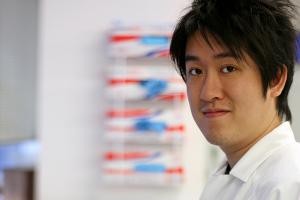Jul 6 2011
"As a kid I always wanted to do something that would benefit others," says Joshua Chou.
As a UTS Chancellor's Postdoctoral Research Fellow and an Endeavour Award recipient who specialises in biomaterials, tissue engineering and drug-delivery systems, Chou is doing just that.
Along with a team of UTS researchers, he is working on the development of a new graft material that will help the human body rebuild its own bones.
 Dr Joshua Chou, photo by Joanne Saad.
Dr Joshua Chou, photo by Joanne Saad.
The material is based on corals and coral sands, which have a unique architectural structure.
"These coral structures can't be reproduced synthetically - it's amazing what nature can provide," he says.
"As part of my research we're trying to determine what is in the organic component of the coral that allows it to promote this bone regeneration.
"If we can isolate it and identify it, then maybe we can develop a cocktail that can be incorporated with other biomaterials to promote better tissue regeneration."
Currently, bone grafts or implant materials are made of metallic substances which the body recognises as being foreign objects. These implants have a lifespan of around 15 years before revision surgery is required to remove or replace them.
"In the case of very elderly patients, this revision surgery sometimes poses a huge risk," Chou says.
"With the corals, however, your body actually builds its own new bones. So instead of having a metallic implant for life, your body re-grows itself, which is much better."
Chou, who undertook his undergraduate, honours and PhD studies at UTS, says his success as a researcher in the field of biomaterials has been driven by something bigger than just an interest in science.
"My mother suffers from osteoporosis, so I know first-hand how bone-related diseases can affect patients and their families.
"This research is very important to me on a personal level."
At a global level, the need for effective bone-graft and tissue-regeneration technologies is vital. An ageing population means an increase in osteoporosis and bone fractures that can hamper the ability of elderly people to take care of themselves.
"We're an ageing society; so everyone, more or less, is going to have some sort of bone problem - either osteoporosis, loss of bone density or broken bones," Chou says. "It's crucial that we develop an effective solution."
The development of stem-cell technologies is rapidly taking the field of biomaterials forward. Researchers are developing custom-made biomaterials that are specifically designed for individual patients, as well as others that target particular ailments and diseases.
"What scientists are working on is to make these materials more bioactive, meaning they are trying to foster more interaction between the material and the surrounding environment to promote a better integration, and therefore, better bone regeneration," says Chou.
"The use of stem cells will allow materials to be tailor-made to suit an individual; these therapies can reduce the probability of rejection by the body.
"I think in the next 10 years we'll be seeing see more and more custom-made biomaterials being developed."